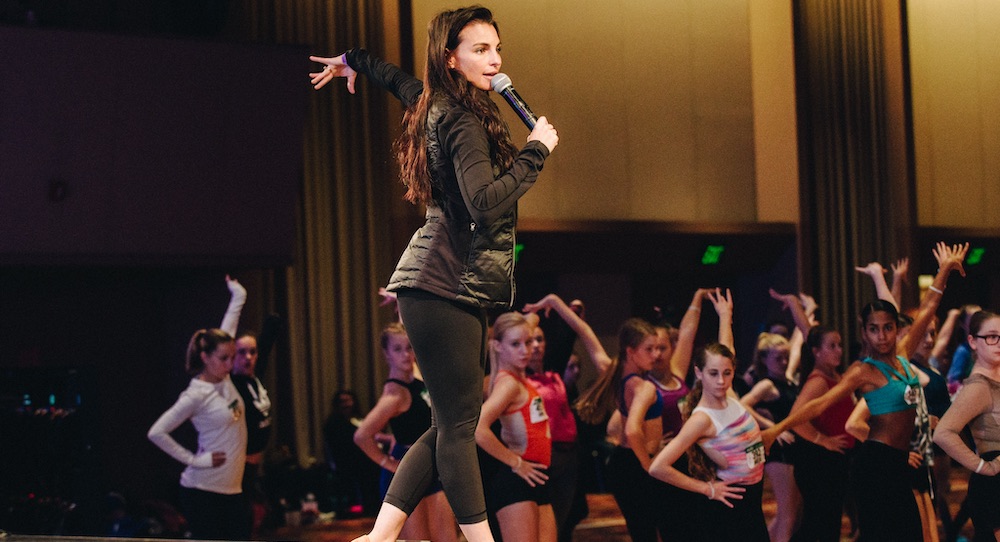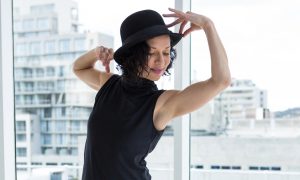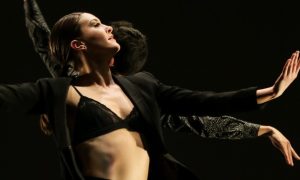Ballroom dance is a stunning form – it requires grace, agility, partnering skills, incredible connection, finesse and precise technique. And when it’s done well, it is absolutely mesmerizing. It’s no wonder, then, that ballroom has become a prominent form of dance in mainstream media. Shows like Dancing with the Stars, World of Dance and So You Think You Can Dance feature ballroom, and, most recently, ABC network premiered Dancing with the Stars: Juniors, so now even kids are getting into it! So ballroom-style dance is certainly not just a skill for adults at weddings; younger dancers can learn and add ballroom to their repertoire, making them even more fearless and versatile performers.
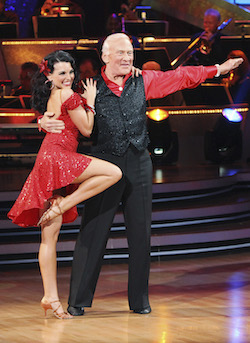
Ashly Costa and Buzz Aldrin on ‘Dancing with the Stars’. Photo by ABC/Adam Larkey.
With this idea in mind, Break the Floor Productions has now added ballroom to its conventions! So now even more young dancers can be exposed to this style, and the merging of the contemporary/jazz world with the ballroom world leaves exciting possibilities for the future.
“I am elated to see more ballroom coming to the convention scene,” says Erica Marr, ballroom instructor for JUMP Dance Convention. “I believe it helps expose kids who may not have ballroom in their studio program to try out a new style and not be intimidated by it. I want to leave kids feeling excited and motivated about pursuing this style, not overwhelmed.”
Marr grew up studying several styles of dance – contemporary, ballet, jazz, hip hop, lyrical and tap – but found her true love for ballroom at the age of 17. She says that through ballroom and Latin movement, she was finally able to fully express herself the way she was meant to.
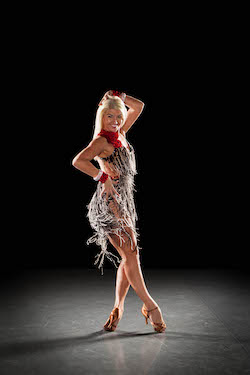
Erica Marr. Photo by JakeJo Photography.
In addition to ballroom being fun and expressive for Marr, she says it’s also a hugely beneficial form for dancers to study. “When training with a partner, you acquire a lot of spatial awareness because your own steps not only affect you but also your partner. You learn complete isolation in your body. We rarely have our hips and shoulders square because we want to show hip rotation. I also believe it improves your musicality.”
“Ballroom teaches so many valuable dance skills,” adds Kim DelGrosso, co-owner of Center Stage Performing Arts Studio, where top ballroom dancers Derek and Julianne Hough, Chelsea Hightower, Jared Murillo, Lyndsey Arnold, Whitney Carson and more got their start. “The male and female roles are beautiful. The manners and etiquette supports dance disciplines. It teaches dancers rhythm, performance, athleticism, team skills and communication skills.”
Four of DelGrosso’s young students are currently starring on the new Dancing with the Stars: Juniors, and three are on tour with World of Dance. She is excited that ballroom dance is now becoming more prominent in the convention scene, so that more young dancers can learn this style.
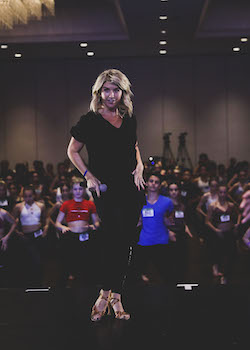
Erica Marr. Photo by @kgphotos.
“Through the introduction to the dance world of the ballroom style, and vice versa, the dance community now respects one another,” DelGrosso says. “Break the Floor has been such an important part of this growth. The huge response to this addition demonstrates the excitement that ballroom dance has on this generation of dancers, competitors and audience. Passed down through the ages, this new generation of dancers honors this incredible style of dance.”
Ashly Costa, ballroom instructor at NUVO, is thrilled to see ballroom becoming a part of the competition dance world. And as a classically trained dancer herself, she has the ability to really connect with and explain the style to contemporary, jazz and ballet dancers. “I can speak their language and translate the often complicated world of ballroom into terms they can relate to and really help them understand the movement.”
In Costa’s ballroom classes at NUVO, dancers will often start out learning an international cha cha, international samba or the jive. “First, they will learn the rhythm of the dance and then a couple of basic technique steps,” she elaborates. “I create really fun combos for each of my classes that include all the basic technique steps set to fun music. Even though ballroom is a complex dance style, I am able to simplify it so that it can be approachable and easy to learn for every dancer.”
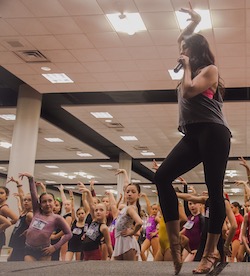
Ashly Costa. Photo by Katharine Rich.
Similarly, in Marr’s ballroom classes at JUMP, she says she will lead them with loads of energy and guarantees dancers will have fun. “My choreography commonly fuses Latin and jazz together, making it very relatable to kids on the convention scene,” she notes. “I make sure not to overwhelm them with too much information but will go over technical details in the beginning. Most of the time, everyone is left feeling very motivated and excited!”
And dancers aren’t always required to dance with a partner to reap the benefits of these ballroom classes. “When teaching at JUMP, my approach is to be able to implement technique and choreograph individual movement not only pertaining to partnering, so everyone can partake!” she says.
But, as partnership dancing is a large component of ballroom dance, and having a partner is required when competing in the form, dancers also shouldn’t be shy or worried about dancing with someone else.
“It is truly addicting to dance in partnerships and experience the feeling of accomplishment at competition and performances,” DelGrosso says. “All dance forms have partnership choreography at some point, but in ballroom, it is the only way you can compete at ballroom comps. My dancers have such an advantage because they were so comfortable with partnering. It has made all the difference.”
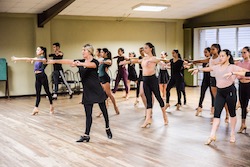
Erica Marr. Photo by @kgphotos.
And dancing with another person can be a really special thing. “Ballroom dancing speaks to the innate desire we all have for love and companionship,” Costa expresses. “When ballroom couples dance together, their performances embody this desire. The longing, joys and struggles we all experience in love are told through the elegance of movement and balance.”
Break the Floor will also offer ballroom as a competition category in its competition convention format. “This is a most exciting opportunity for ballroom dancers!” says DelGrosso. “They have amazing ballroom professionals teaching and judging the ballroom numbers. It has allowed so many dancers who may have never had an opportunity to learn ballroom to embrace this beautiful dance form. So many studios are now hiring local ballroom teachers to teach and choreograph. Break the Floor has connected the mainstream competitive dancer with the resources of the ballroom world.”
The inclusion of ballroom dance in the convention circuit brings even more people together now, and it offers dancers just one more skill to add to their toolbox, a skill that could set them apart from another dancer at an audition or competition in the future.
“I truly believe that ballroom will help this next generation of dancers become more versatile and disciplined,” Costa says. “Students who learn ballroom and develop related skills will have a wider range of knowledge, be able to partner better, know the differences between ballroom and other dance styles and ultimately book more jobs. They will also have a greater understanding of music, beats and rhythm.”
For more information on Break the Floor, JUMP and NUVO, and to find out the next convention closest to you, visit www.breakthefloor.com.
By Laura Di Orio of Dance Informa.


